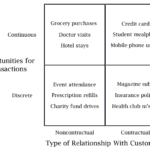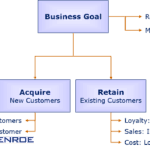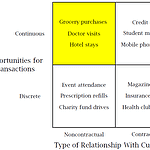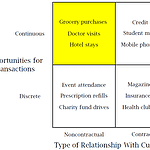As a C-suite leader managing a business through transformation, you scrutinize every asset to drive more value – but are you applying the same financial rigor to your most valuable asset: your customer base?
Your customer is your most powerful asset
Everyone nods wisely at those words, yet, how many organisations actually do manage and monitor their customers as assets?
Very few.
Companies rarely use the same rigorous tools and processes to manage customer assets as they do to manage their other assets.
In this post I’ll review why and how to apply financial rigour to your customer asset management.
Key Takeaways for C-Suite Leaders
Strategic Value Creation
- Apply the same financial rigor to your customer portfolio as you do to your capital assets
- Transform customer reporting from basic metrics to financial insights
- Align customer portfolio management with your broader business transformation goals
Risk Management & Governance
- Evaluate customer-related decisions through the same risk/return lens as other major assets
- Enable board-level oversight of customer assets with financial metrics and portfolio analysis
Operational Efficiency
- Optimise return on existing customers before investing in new customer acquisition
- Integrate customer asset management into your existing financial reporting framework
Customers have the Same Attributes as Other Assets
In a very practical sense, customers have the same attributes as other financial assets and should be treated as such.
For example, let’s compare a typical financial asset, Plant and Equipment, with customers.
| Feature | Customers | Plant and Equipment |
|---|---|---|
| Quality | Propensity to bad debt Cost to serve and retain Customer lifetime | Propensity to unexpected failure Cost to maintain and repair Service lifetime |
| Returns | Gross margin Potential gross margin | Operating throughput Maximum throughput |
| Acquisition and disposal | Cost to acquire Acquisition Defection | Capital cost Equipment acquisition Equipment retirement |
When managing other financial assets, organisations will carefully examine the entire asset lifecycle from acquisition to disposal and weigh up the pros and cons of different quality / return trade-offs for each purchase.
However, very few organisations do this same task for their Customer Assets.
The crux of the matter is that organisations typically do not understand, manage and report on customers in similar ways to financial assets.
Many organisations report regularly on ad hoc pieces of customer information such as the number of new customers and existing customers in total. However, without reporting by customer value, this can be misleading Customer Asset information, as the organisation could be acquiring unprofitable customers and losing profitable ones.
Reframing the Organisation’s View of Customers as Assets
Changing the organisation’s view of customers to that of a managed financial asset is not just an interesting theoretical framework but a practical approach to meeting business goals.
So what needs to change in organisations to drive the maximum value in the business?
There are key areas to address:
Corporate Governance
In the same way that boards actively manage their non-customer asset base they must actively manage their Customer Asset base.
For instance, no Board would contemplate changing the capital structure of the company without examining how it might affect the organisation’s credit rating. Yet the same Board doesn’t even question how a marketing campaign might impact the bad debt profile of its Customer Assets, with an equal impact on the organisation’s credit rating.
Boards and executive management must manage their Customer Assets in financial terms and have an understanding of how different business strategies impact on the Customer Asset return/risk profile created.
As another example of the way governance structures should approach Customer Assets, lets review how a company might approach two analogous situations.
In the first situation a company wants to expand production capacity.
Rather than immediately purchasing new equipment, hiring staff and building new facilities, it first tries to make the current equipment work harder, i.e. improve the return on assets.
They look at reducing bottlenecks, optimising configurations, running closer to full capacity, improving maintenance to reduce downtime, etc.
Only after all those options have been investigated does it purchase new production capacity.
In the second situation the same company wants to grow revenue.
Do they focus on working that assets harder? Hardly, marketing and sales is fired up to hunt and close new customers.
This is the equivalent of buying new equipment when it hasn’t even looked at how well the old equipment is working.
A better approach is to examine the current Customer Assets to see if they can be worked harder, i.e. can it sell more to the existing customers (equivalent to increasing throughput) or reduce customer outflow (equivalent to extending working life).
Manage Customers as an Asset Portfolio
Just like non-Customer Assets, each individual Customer Asset (i.e. customer) exhibits a different return / quality profile.
A company’s customer base is, in effect, an asset portfolio to be actively managed.
The analogy with modern portfolio theory is very strong because both ideas are based on building an optimal risk/return portfolio on a spread of assets. In order to maximise outcomes it is necessary to create a balanced portfolio of different customer types.
It follows then that for maximum return, customers need to be managed in a similar way a high net-worth financial advisor would manage an investment portfolio, by creating a balance between customers with different returns / quality profiles.
This is an active not passive process.
Companies that actively manage their customer acquisition, migration and disposal are able to closely match their Customer Asset portfolio to their business needs.
Reporting
It has already been noted that the difference between customer reporting and other asset reporting in most companies is stark.
Request a Plant and Equipment Report in most companies and you will receive a detailed description of acquisition, disposal, lifetime costs, liabilities, etc.
Request a Customer report in the same organisation and you’ll get a list of customer names with, maybe, recent revenue.
You’re unlikely to receive an integrated report showing acquisition costs, attrition levels, up sells, down sells and lifetime values.
So to manage customers as financial asset substantial changes are needed in the way organisations view and report on Customer Assets.
Critical Customer Asset information is not their name (in fact this is the least useful piece of information) and product holdings.
It is customer lifetime values, migration movements, potential credit risks, gross margins, future customer revenue lost, etc.
With this information it is possible to manage the Customer Asset portfolio more efficiently and effectively.
In summary, many organisations do not realise that customers are a financial asset and can be managed the same way as all other financial assets. Changing the organisation’s perspective to managing customers as a financial asset can make a huge difference to the organisation’s bottom line and future growth.
I've created an Excel Customer Lifetime Value Calculator: Download Here








